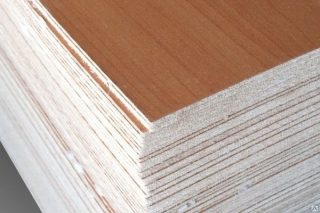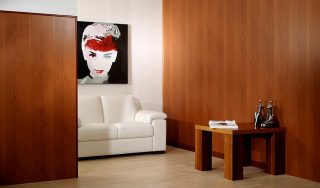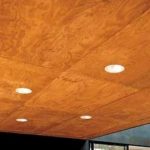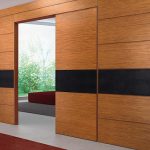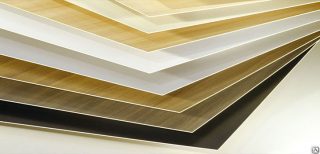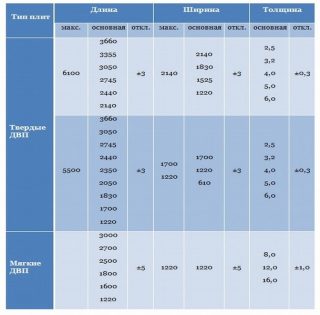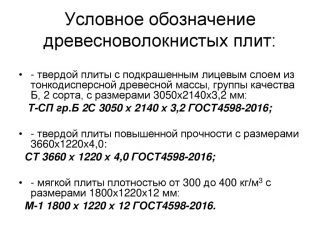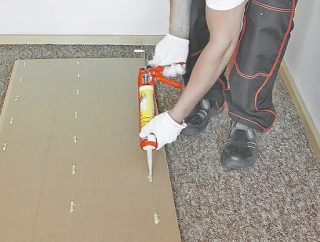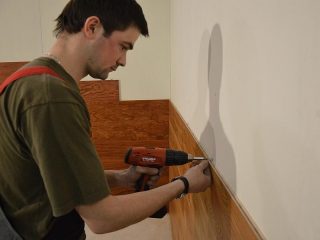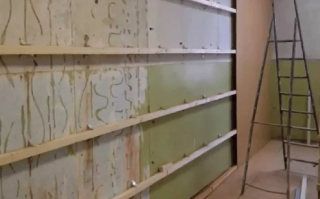Wood fiber panels are produced by pressing wood fibers under pressure under high temperature conditions. To bind the particles, synthetic resins are added, the quality is improved with the help of modifying additives and a special film. Laminated fiberboard is in demand in construction, furniture industry, and in the manufacture of doors.
Material description
Distinguish lamination methods:
- protective and decorative films (PVC, melamine, phenolic), thermosetting polymers;
- paper-resin membrane (for protection only);
- decorative look of thin veneer.
Slab ends also treated with waterproof compounds. Distinguish between sheets processed from one or two sides. Films are smooth, with a mesh relief surface and with a coating intended for painting.
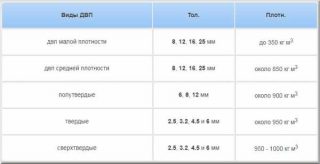
Distinguish between panels by density:
- medium - fiberboard SP up to 400kg / m³;
- high - fiberboard VP 400 - 800 kg / m³;
- superhard - fiberboard ST more than 800 kg / m³.
Conditional marking includes coating grade, texture, formaldehyde emission class, nominal dimensions and thickness. The first indicator is put down in the form of a fraction: in the numerator - the front cover, and in the denominator - the back side.
Features of production
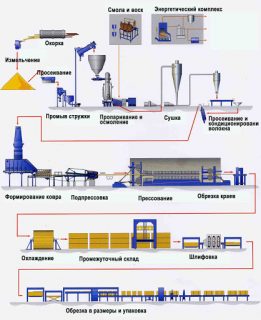
The raw material is shredded wood chips, bark, shredded compressed with additional ingredients. Lamination improves the appearance, material properties, and its consumer characteristics.
Manufacturing specifics:
- The film is applied without glue, using a heat press and polymer thermosetting impregnation.
- The impregnated layer is prepared from a fast curing resin to increase the chemical and mechanical resistance.
- The volume of resins should not exceed 4 - 8% of the volume of the fibrous ingredients.
- Melamine resins under pressure partially melt, penetrate into the surface of the board, providing a strong fixation.
- On top of the uncured film, a press is again used to form an embossing, imitation of the relief of wood fibers.
Fiberboard sheets laminated from soft wood chips are produced without resin binder - in the process, the property of lignin (in the composition of the fibers) is used to glue under the action of high temperature. Introduce into the mass antiseptics and fire retardants to protect against microorganisms and increase resistance to ignition. For superhard panels, pectol (tall oil cracking product) is used. The additive increases the strength by 20 - 25%.
Application
Laminated sheets are used in civil and industrial construction:
- finishing of ceilings, protruding floor beams;
- covering curved areas in the manufacture of multi-tiered suspended ceilings;
- full height wall cladding or panels in combination with putty, paint, wallpaper, cork:
- installation as a decoration on the arched surfaces of doorways, window arches;
- sheathing of interior and office partitions, sometimes the material is placed on a frame without a chipboard or drywall base;
- to create ventilation ducts as a sound insulating layer.
Furniture industry uses laminated wood fiber panels for finishing cabinet cases, tables, and other items.
Fiberboard is used in vehicle finishing, subway cars, trains, cars.
Types of sheets
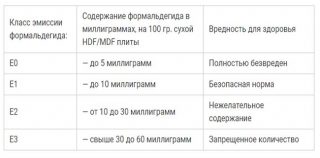
As part of the laminated fiberboard on the walls there is formaldehyde resins, therefore, the material is distinguished by the amount of such a substance and its emission into the air of the room.
Allocate 3 classes:
- E0 - the material does not emit harmful components;
- E1 - no more than 10 mg per 100 g of the plate;
- E2 - 10 - 30 mg per 100 g of the panel.
Fibreboard of the zero and first class is used for the manufacture of furniture. E2 class cannot be used for household needs, housing upholstery, production of children's and room furniture. Some countries have refused to release such material.
- for mechanical and physical properties - quality categories A and B;
- in appearance - I and II grade;
- according to the degree of gloss - matte and glossy;
- by type of printing layers - one-color and with a printed image.
- in texture - smooth and embossed.
There is material in the form of tiles, on the sides of which a tongue-and-groove connection is provided, and they are fixed to the crate with the help of cleats. There are laminated types of fiberboard for lining, in the form of oblong panels. Docking is done according to the type of tiled varieties. The sheet type is a standard versatile material.
Dimensions and thickness
The standards recommend the following thicknesses for the production of MDF panels:
- medium density products - 8, 12, 16, 25 mm;
- high - 6, 8, 12 mm;
- superhard - 3, 5, 6 mm.
The dimensions of laminated fiberboard in width are 1.22 and 2.14 m, and the length is 1.22 and 3.66 m.The weight of a MDF sheet can be at the level of 8 -15.5 kg, the weight depends on the dimensions, density and thickness.
Criterias of choice
When choosing, they are guided by the rules:
- study the marking with letters and numbers, determine the grade, class and other indicators;
- visually inspect the sheets so as not to acquire curved ones, such products have been exposed to moisture, so the curvature cannot be corrected;
- calculate the optimal width and height of the panels so that there is less waste.

Wall Mount
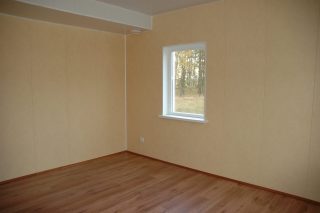
Cut sheets into the desired pieces by size you can hacksaw, in the case of a large number of cuts, use electric jigsaw with wood saw... The difficulty is that the foxes bend from side to side, especially for large panels (up to 3.66 m long). If possible, order the cutting at the place of purchase.
On the walls fix laminated boards in three ways:
- glued to the surface;
- fastened with self-tapping screws or nailed (wooden bases);
- placed on a crate made of a wooden lath or galvanized profile.
The wooden lath is impregnated with linseed oil three times, while the next layer is applied after the previous one has dried.
With glue
After plastering, check the plane with a level and a plumb line, then its soil with deep penetration compounds.
Operating procedure:
- the sheet is cut to size, greased with glue;
- the composition is applied to the inside, leveled with a notched trowel;
- the sheet is lifted and pressed against the wall;
- hold for about two minutes to set.
The following products are attached in the same sequence. The glue is chosen ready-made mastics for this material or use PVA glue.
For screws or nails
Attachment rules to different surfaces:
- hardware is attached to wooden walls directly using a screwdriver or drill;
- holes for plastic dowels are pre-drilled in a concrete or brick wall, then the sheets are fixed using driven or twisted self-tapping screws.
Before installation, the wall material is brought into the room, kept there for about a day, so that the panels are equal in temperature and humidity with the surrounding space.
Self-tapping screws with a diameter of no more than 5 mm are chosen, the length is determined so that after passing through the thickness of the plate, the hardware enters the wall by 15 - 20 mm.
On the crate
Fasten the MDF on the side after 20 - 25 cm, retreating from the edge by 1 - 1.5 cm to prevent cracking. Self-tapping screws are fixed along the central lines with a similar pitch.

